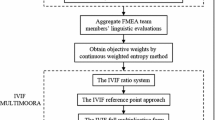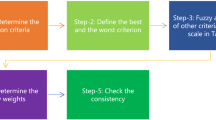Abstract
Failure modes and effects analysis (FMEA) is used in product design as a systematic analysis tool that aims to identify and evaluate potential failure modes, their causes and effects. However, vital information for FMEA, such as consumer needs and expert opinions, is often uncertain or vague in the product design phase. On the other hand, fuzzy logic is a technique that has been used to overcome the absence of concrete data and generate robust results to drive decisions from uncertainties. In this sense, this paper proposes a methodology that combines the concepts of fuzzy logic and product FMEA. In the proposed approach, the parameters severity, occurrence and detectability are evaluated in a fuzzy inference system. Its applicability was investigated with the help of an illustrative case study. Fuzzy FMEA was carried out to prioritize risks on one module of a Jerusalem artichoke processing equipment. The results provide an alternate ranking to that obtained by the traditional method. The conclusion is that the proposed methodology enables experts to combine occurrence probability, severity and failure modes detectability in a more flexible and realistic manner by using their judgement and experience.
Similar content being viewed by others
References
Chin KS, Chan A, Yang JB (2008) Development of a fuzzy FMEA based product design system. Int J Adv Manuf Technol 36:633–649. https://doi.org/10.1007/s00170-006-0898-3
Teoh P, Case K (2005) An evaluation of failure modes and effects analysis generation method for conceptual design. Int J Comput Integr Manuf 18:279–293. https://doi.org/10.1080/0951192042000273122
Zafiropoulos EP, Dialynas EN (2005) Reliability prediction and failure mode effects and criticality analysis (FMECA) of electronic devices using fuzzy logic. Int J Qual Reliab Manag 22:183–200. https://doi.org/10.1108/02656710510577233
Pahl G, Wallace K, Blessing L (2007) Engineering design: a systematic approach. Springer, London
Liu HC, Liu L, Liu N, Mao LX (2012) Risk evaluation in failure mode and effects analysis with extended VIKOR method under fuzzy environment. Expert Syst Appl 39:12926–12934. https://doi.org/10.1016/j.eswa.2012.05.031
Zadeh LA (1965) Fuzzy sets. Inf Control 8(353):338–353. https://doi.org/10.1142/9789814261302_0021
Pedrycz W, Gomide F (1998) An introduction to fuzzy sets: analysis and design. Bradford, London
Guimaraes ACF, Lapa CMFL (2004) Fuzzy FMEA applied to PWR chemical and volume control system. Prog Nucl Energy 44:191–213. https://doi.org/10.1016/j.pnucene.2003.12.001
Ben Romdhane T, Badreddine A, Sansa M (2017) A new model to implement Six Sigma in small- and medium-sized enterprises. Int J Prod Res 55:4319–4340. https://doi.org/10.1080/00207543.2016.1249430
Savino MM, Brun A, Riccio C (2011) Integrated system for maintenance and safety management through FMECA principles and fuzzy inference engine. Eur J Ind Eng 5:132. https://doi.org/10.1504/EJIE.2011.039870
Liu HT, Tsai Y (2012) A fuzzy risk assessment approach for occupational hazards in the construction industry. Saf Sci 50:1067–1078. https://doi.org/10.1016/j.ssci.2011.11.021
Niu X, Liu Y, Song Y et al (2017) Rosin modified cellulose nanofiber as a reinforcing and co-antimicrobial agents in polylactic acid/chitosan composite film for food packaging. Carbohydr Polym. https://doi.org/10.1016/j.carbpol.2017.11.079
Xu K, Tang LC, Xie M et al (2002) Fuzzy assessment of FMEA for engine systems. Reliab Eng Syst Saf 75:17–29. https://doi.org/10.1016/S0951-8320(01)00101-6
Schneider H (1996) Failure mode and effect analysis: FMEA from theory to execution. Technometrics 38(1):80. https://doi.org/10.1080/00401706.1996.10484424
GENERAL MOTORS CORP (2008) Potential failure mode and effects analysis FMEA: reference manual, 4th edn. AIAG
Pelaez CE, Bowles JB (1996) Using fuzzy cognitive maps as a system model for failure modes and effects analysis. Inf Sci (Ny) 88:177–199
Lee BH (1999) Design FMEA for mechatronic systems using Bayesian network causal models. In: Proceedings of 1999 design engineering technical conferences and design automation conference DETC-99/DAC-8605, Las Vegas, USA, pp 1235–1246
Dyadem Engineering Corporation, Press D, Press C (2003) Guidelines for failure mode and effects analysis for automotive, aerospace and general manufacturing industries. CRC Press, Boca Raton
McDermott R (2011) The basics of FMEA, 2nd edn. CRC Press, Boca Raton. https://doi.org/10.1017/cbo9781107415324.004
Liu HC, Liu L, Liu N (2013) Risk evaluation approaches in failure mode and effects analysis: a literature review. Expert Syst Appl 40:828–838. https://doi.org/10.1016/j.eswa.2012.08.010
Klirk GJ, Yuan B (1995) Fuzzy sets and fuzzy logic. Theory and applications. Prentice Hall Inc., Upper Saddle River
Ross TJ (2009) Fuzzy logic for engineering applications, 4th edn. Wiley, Rio Rancho
Aqlan F, Mustafa Ali E (2014) Integrating lean principles and fuzzy bow-tie analysis for risk assessment in chemical industry. J Loss Prev Process Ind 29:39–48. https://doi.org/10.1016/j.jlp.2014.01.006
Wang YM, Chin KS, Poon GKK, Yang JB (2009) Risk evaluation in failure mode and effects analysis using fuzzy weighted geometric mean. Expert Syst Appl 36:1195–1207. https://doi.org/10.1016/j.eswa.2007.11.028
Pillay A, Wang J (2003) Modified failure mode and effects analysis using approximate reasoning. Reliab Eng Syst Saf 79:69–85. https://doi.org/10.1016/S0951-8320(02)00179-5
Hu AH, Hsu CW, Kuo TC, Wu WC (2009) Risk evaluation of green components to hazardous substance using FMEA and FAHP. Expert Syst Appl 36:7142–7147. https://doi.org/10.1016/j.eswa.2008.08.031
Posselt EL, Frozza R, Molz RF (2015) INFUZZY: ferramenta para desenvolvimento de aplicações de sistemas difusos (INFUZZY: Tool for development of fuzzy systems applications). Rev Bras Comput Apl 7:42–52. https://doi.org/10.5335/rbca.2015.3960
Sharma RK, Sharma P (2012) Integrated framework to optimize RAM and cost decisions in a process plant. J Loss Prev Process Ind 25:883–904. https://doi.org/10.1016/j.jlp.2012.04.013
Chen LH, Ko WC (2009) Fuzzy approaches to quality function deployment for new product design. Fuzzy Sets Syst 160:2620–2639. https://doi.org/10.1016/j.fss.2008.12.003
Ma H, Chu X, Xue D, Chen D (2017) A systematic decision making approach for product conceptual design based on fuzzy morphological matrix. Expert Syst Appl 81:444–456. https://doi.org/10.1016/j.eswa.2017.03.074
Sharma RK, Kumar D, Kumar P (2005) Systematic failure mode effect analysis (FMEA) using fuzzy linguistic modelling. Int J Qual Reliab Manag 22:986–1004. https://doi.org/10.1108/02656710510625248
Zimmermann H-J (2001) Fuzzy set theory—and its applications. Springer, Dordrecht. https://doi.org/10.1007/978-94-010-0646-0
Márquez FA, Peregrín A, Herrera F (2007) Cooperative evolutionary learning of linguistic fuzzy rules and parametric aggregation connectors for Mamdani fuzzy systems. IEEE Trans Fuzzy Syst 15:1162–1178. https://doi.org/10.1109/TFUZZ.2007.904121
Mamdani EH, Assilian S (1975) An experiment in linguistic synthesis with a fuzzy logic controller. Int J Man Mach Stud 7:1–13. https://doi.org/10.1016/S0020-7373(75)80002-2
Altrock CV, Krause B (1994) Multi-criteria decision making in German automotive industry using fuzzy logic. Fuzzy Sets Syst 63(3):375–380
Moura CR, Silva JO, Scalice RK (2014) Development of equipment for jerusalem artichoke processing. Product 12:41–48
Author information
Authors and Affiliations
Corresponding author
Additional information
Technical Editor: Dr. Fernando Antonio Forcellini.
Appendices
Appendix A: systematic literature review
The search was performed on September 2018, using SCOPUS database with the following features:
-
Search string: ((FMEA OR FEMECA OR “Failure Mode”) AND “Fuzzy Logic”). The term “Failure Mode” was incorporated due to the absence of the acronyms in some papers on the adopted search fields.
-
Search fields: Article Title, Abstract and Keywords.
-
Subject area: Engineering.
-
Language: English.
-
Source: Journals.
-
Publish year: all.
This search resulted on 61 documents, listed on Table 5. Among these documents, 47 are published in the last 10 years.
As a second filter, it has performed a search using the string “Mamdani” in the full text of the selected papers. The term “Mamdani” corresponds to the author of the fuzzy method employed on our proposal. It resulted on 13 papers to be further evaluated, represented by the numbers: 3, 11, 12, 17, 21, 22, 39, 40, 50, 52, 60 and 61. At this point, the papers passed through a reading process of theirs full text, resulting on the selection of five papers to be included on the research, as explained in Table 6. The remaining papers are part of the research described on this paper.
Appendix B
A numerical example for the calculation of the fuzzy RPN in a failure risk with severity = 6, occurrence = 5 and detectability = 10.

Rights and permissions
About this article
Cite this article
de Aguiar, J., Scalice, R.K. & Bond, D. Using fuzzy logic to reduce risk uncertainty in failure modes and effects analysis. J Braz. Soc. Mech. Sci. Eng. 40, 516 (2018). https://doi.org/10.1007/s40430-018-1437-5
Received:
Accepted:
Published:
DOI: https://doi.org/10.1007/s40430-018-1437-5









